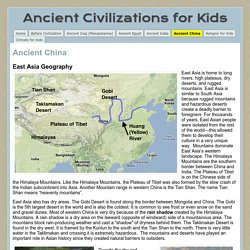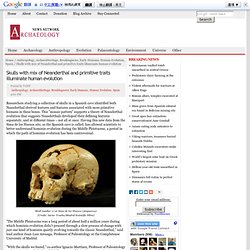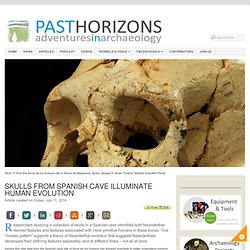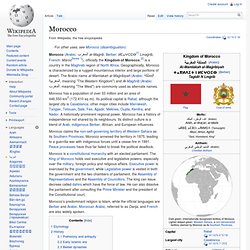

Etta
'Britain's Atlantis' found at bottom of North sea - a huge undersea kingdom swamped by a tsunami 5,500 years ago. Divers have found traces of ancient land swallowed by waves 8500 years agoDoggerland once stretched from Scotland to DenmarkRivers seen underwater by seismic scansBritain was not an island - and area under North Sea was roamed by mammoths and other giant animalsDescribed as the 'real heartland' of EuropeHad population of tens of thousands - but devastated by sea level rises By Rob Waugh Published: 23:32 GMT, 2 July 2012 | Updated: 10:49 GMT, 3 July 2012.

Enormous megaliths discovered in Siberia. Click here to view the original image of 610x400px.

Swedish divers unearth a 'Stone Age Atlantis': 11,000-year-old ancient settlement discovered under the Baltic Sea. Divers found a harpoon, tools, horns and the bones of ancient cattle The bones belonged to the animal auroch last seen in the early 1600sArchaeologists believe these relics date back to the Stone AgeIt is said to be the oldest settlement in the area - dubbed Sweden’s 'Atlantis' By Victoria Woollaston Published: 16:06 GMT, 27 January 2014 | Updated: 17:16 GMT, 27 January 2014.

100 Incredible YouTube Channels for History Buffs » Online College Search. If you love history, or just want to learn more about it, YouTube has exactly what you need.

Always up to the challege of providing thorough, accurate information, YouTube delivers channels from leading names in historical studies, from The Smithsonian to the Discovery Channel. You’re sure to find just the right information you need for your lecture, lesson plan, or perhaps just your personal viewing pleasure. General History These videos can give your students a better insight into historical events. Art History. Archeology. Egyptian Mythology. Ancient History. Ancient China - Ancient Civilizations for Kids. East Asia also has dry areas.

The Gobi Desert is found along the border between Mongolia and China. The Gobi is the 5th largest desert in the world and is also the coldest. It is common to see frost or even snow on the sand and gravel dunes. World History. World History. Ancient China. Mythology. Religion. Ancient Mesopotamia (Middle East) Inuit Myth and Legend. Inuit mythology is a repository of Inuit culture, passed down by elders through generations to enrich and enlighten.

My Mother's Story. Ancient Mesopatamia. History. Ancient History. Egyptian Mythology. Ancient Civilisations. History. New York NY. Arabian, Hindi & Persian (pre Iraq & Iran) Antiquity & More. Ancient near eastern Religions. 'Atlantis' History. Mesopotamia & the Ancient Near East. History of Man. The First Americans. In the 1970s, college students in archaeology such as myself learned that the first human beings to arrive in North America had come over a land bridge from Asia and Siberia approximately 13,000 to 13,500 years ago.

These people, the first North Americans, were known collectively as Clovis people. Their journey was made possible, according to archaeologists far and wide, by a corridor that had opened up between giant ice sheets covering what is now Alaska and Alberta. Thus did the Clovis people move down through the North American continent, carrying their distinctive tools to various sites in the Plains States and the Southwest and then moving eastward.
And all of this they did very quickly. Significant evidence of Clovis culture had been discovered in New Mexico. Clovis First, as it was called, was the one and only accepted explanation of initial human arrival and subsequent expansion throughout North and South America. Miller wondered what else lay beneath that patch of soil. The Archaeology News Network: Skulls with mix of Neanderthal and primitive traits illuminate human evolution. Researchers studying a collection of skulls in a Spanish cave identified both Neanderthal-derived features and features associated with more primitive humans in these bones.

This "mosaic pattern" supports a theory of Neanderthal evolution that suggests Neanderthals developed their defining features separately, and at different times – not all at once. Having this new data from the Sima de los Huesos site, as the Spanish cave is called, has allowed scientists to better understand hominin evolution during the Middle Pleistocene, a period in which the path of hominin evolution has been controversial. Skulls from Spanish cave illuminate human evolution. Article created on Friday, July 11, 2014 Researchers studying a collection of skulls in a Spanish cave identified both Neanderthal-derived features and features associated with more primitive humans in these bones.

This “mosaic pattern” supports a theory of Neanderthal evolution that suggests Neanderthals developed their defining features separately, and at different times – not all at once. Modern Human faces Neanderthal across the Danube. Dipl.Geol.Univ. The First Americans. Morocco. Morocco (Arabic: المغرب al-Maġrib, Berber: ⵍⵎⴰⵖⵔⵉⴱ[7] Lmaġrib, French: Maroc[Notes 1]), officially the Kingdom of Morocco,[2] is a country in the Maghreb region of North Africa.

Geographically, Morocco is characterized by a rugged mountainous interior and large portions of desert. The Arabic name al-Mamlakah al-Maġribiyah (Arabic: المملكة المغربية, meaning "The Western Kingdom") and Al-Maghrib (Arabic: المغرب, meaning "The West") are commonly used as alternate names. Morocco. Lascaux. La découverte de Lascaux en 1940 a ouvert une nouvelle page dans la connaissance de l’art préhistorique et de nos origines. Œuvre monumentale, la grotte continue de nourrir l’imaginaire collectif et d’émouvoir les nouvelles générations du monde entier. C’est à ce haut lieu de la Préhistoire qu’est dédiée la nouvelle publication multimédia du ministère de la Culture et de la Communication, publication qui réactualise autant la forme que le contenu scientifique de ce site mis en ligne en 1998, à la lumière des dernières avancées de la recherche archéologique. Au delà de l’émotion et à la lumière des recherches les plus récentes, le site internet est destiné à faire comprendre les secrets des artistes qui ont peint et gravé le bestiaire de Lascaux il y a 19000 ans et à présenter les orientations actuelles de la recherche scientifique sur les grottes ornées.
Historia. The Black Pharaohs - Nubian Pharaohs (Ancient Egypt History Documentary) Eg. History. Paleoanthropology and Human Evolution. Ancient near eastern Religions. What have the Romans done for us? Assyrians 1200-1100 BC. Roaming Romans. Neanderthal. Abbasid Caliphate 750-1258. England under the Danes and the Norman conquest 1000s. Assyria. Overview map of the Ancient Near East in the 15th century BC (Middle Assyrian period), showing the core territory of Assyria with its two major cities Assur and Nineveh wedged between Babylonia downstream (to the south-east) and the states of Mitanni and Hatti upstream (to the north-west).
Assyria was a major Semitic kingdom, and often empire, of the Ancient Near East, existing as an independent state for a period of approximately nineteen centuries from c. 2500 BC to 605 BC, spanning the Early Bronze Age through to the late Iron Age. For a further thirteen centuries, from the end of the 7th century BC to the mid-7th century AD, it survived as a geo-political entity, for the most part ruled by foreign powers, although a number of small Neo-Assyrian states arose at different times throughout this period.